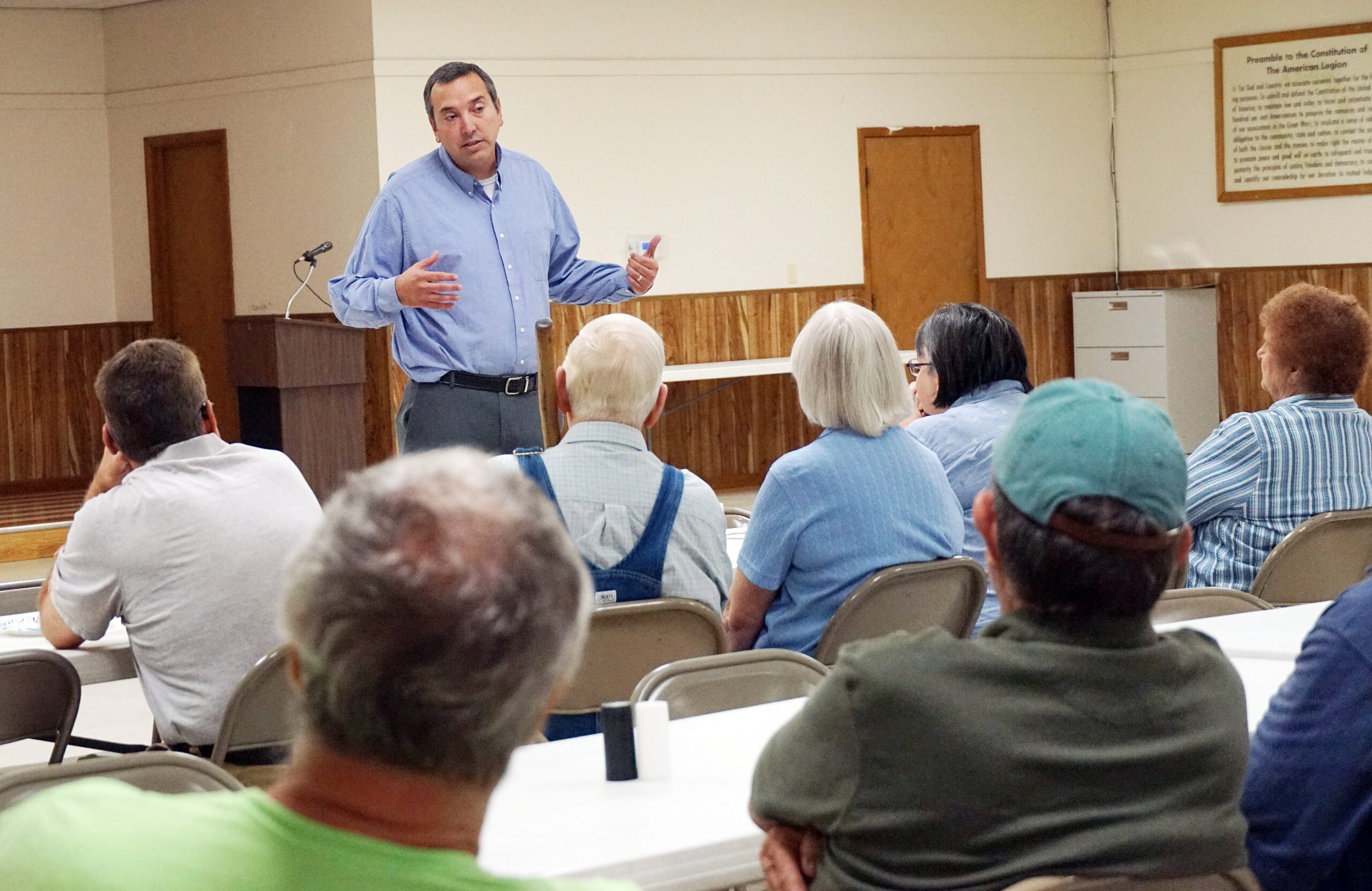Deputy Secretary of Transportation Greg Scheiber explains the delay in the project to a frustrated crowd.
by Holly Allen
More than 90 residents and county officials gathered at the Perry American Legion Sept. 19 for an update to the US-24 road and bridge project west of Perry. Among those in attendance were two county commissioners, the county sheriff, and Rep. Ron Ellis (R-Meriden).
The state’s newly appointed deputy Secretary of Transportation, Greg Scheiber, and Leroy Koehn, lead northeast district engineer for KDOT, were on hand to provide the update and participate in a question and answer session.
The project began in March and includes replacement of the Delaware River Bridge just west of Elm Street in Perry, and resurfacing work on US-24 from approximately the bridge to K-237.
Bettis Asphalt & Construction Inc., Topeka, is the prime contractor on the $12.6 million project.
Though the bridge replacement portion of the project was originally estimated to be completed by November, an anomaly found in the new concrete poured for pillars on the bridge forced that portion of the project to be reworked, causing a two-month delay in the timeline.
“We expected to have unrestricted traffic on the bridge by the end of November, however, we found we didn’t have sound concrete all the way to the bottom of the new pillars,” stated Koehn. “The issue was with the process or procedure of the pour and not with the quality of the concrete itself.”
The subcontractor tasked with drilling the shafts and pouring the pillars was A.M. Cohron & Son, Inc., Iowa. According to Koehn, this particular situation happens, though rarely, in what he estimated to be in about 5% of cases.
Once the anomaly in the integrity of the concrete was detected through crosshole sonic logging, a resolution was sought. The eventual proposal to correct the issue, a low transfer beam, was completed last week.
This delay will mean the project may not be completed until late May, unless the weather affords a very mild winter which would allow crews to continue working. It also means the bridge will continue to be restricted to one lane through the winter months.
Residents and commuters at the meeting expressed frustration at the delay, particularly owing to what they consider a poorly timed construction zone leading to extensively long delays in travel time.
The most aggravation seems to stem from the observation that westbound vehicles wanting to turn north on Ferguson Road cause the bulk of the backup, and the ability to turn right on red at that intersection would greatly improve wait times. When the project began, vehicles were taking it upon themselves to utilize the shoulder as a right turn lane, but barricades were since installed to prevent this. More than one resident suggested the straight lane become a designated right turn lane, and the left turn lane into Perry become the straightaway lane through the remainder of the project to cut down on construction backups.
The suggestion was taken under advisement by Koehn, who admitted he had not been on-site in the construction zone, but planned to do so. He informed those in attendance he would have his team consider that option, but called the setup a “very challenging configuration.”
Several residents refused to back down, with one telling Koehn and Scheiber, “It is crazy how you’re defending this — the guy who designed it should be fired. And now you’re talking about making people put up with it for another eight months?”
Others commented that the setup at US-24 and Ferguson Road had caused a huge issue with the lake over the summer, with boats and trailers unable to maneuver past the barricades to turn north onto Ferguson.
Garrett Perry, co-owner of Bernie’s Convenience Store, which is accessed by that intersection, stated his sales were down astronomically, and echoed the sentiment previously stated in favor of a designated turn lane.
“There’s plenty of room for the left lane to become a straight lane, and the right lane a dedicated right turn lane. All arguing aside, that should be your goal now, to make this work,” he stated.
Another group, headed by resident Susan Alexander, spoke up against the county, stating had something been done to have the old Delaware River Bridge (called the Parker Truss Bridge) repaired or replaced and reopened, residents wouldn’t be dealing with this issue. The iron truss bridge on the west edge of Perry is considered permanently closed by the county, and, according to Public Works Director Ben Domann, would be very costly to replace.
Built in 1926 by the Midland Bridge Co. of Kansas City, the Structural Steel Co., and the Yancy Bros. Construction Co., the structure was listed on the National Register of Historic Places in 2003 and closed to traffic and pedestrians in 2013.
Reopening the bridge would have afforded residents of the area the opportunity to travel west on Bridge Street out of Perry clear through to the community of Newman, avoiding the construction area.
Commissioner Doug Walbridge, in attendance at the meeting, stated the commissioners had previously given the project a letter of support endorsing the search for state or federal monies to assist in repairing the bridge, but reiterated that the cost to repair the bridge was outside of what was possible for the county’s coffers.
He did state, as new grant opportunities have become available, the county would be looking at possibilities for the old bridge.
The county currently has a total of 154 bridges. Of the total, 148 are considered in fair or good condition. Four are in poor condition, and two, including the old Delaware River Bridge and one located on Big Slough Creek, 2.2 miles west of Oskaloosa, are considered permanently closed.


